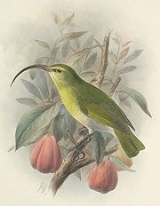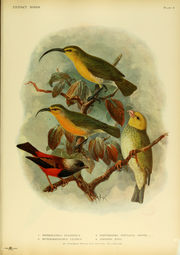
Oahu 'Akialoa
Encyclopedia

Finch
The true finches are passerine birds in the family Fringillidae. They are predominantly seed-eating songbirds. Most are native to the Northern Hemisphere, but one subfamily is endemic to the Neotropics, one to the Hawaiian Islands, and one subfamily – monotypic at genus level – is found...
in the Fringillidae family. The Oahu Akialoa was a species of Akialoa, or long-billed insectivorous bird that was that was found in the high elevation forest. It was a dull colored species, dull green on the belly, bright green on tail on rump and tail, dark olive-grey back and speckled yellow and green on the head. It was endangered from the loss of habitat; it was very prone to Avian Flu, a disease that was introduced by the mosquito. This bird was mainly an insectivore using its bill to probe through the bark in search of bugs to eats. It also used its long bill to go into flowers to reach their stores of nectar. When the forests are cleared the bird could not find any food, as a result, they would starve. The birds were also weak against the natural diminishing factors like weather and competition from other native nectar feeding birds. Scientists were sure that this bird was still common in the 1860’s, evidence found by Perkins. Afterward, few reports came in, though two were presumed to be seen in 1933 and one in 1940. It was endemic to the island of Oahu
Oahu
Oahu or Oahu , known as "The Gathering Place", is the third largest of the Hawaiian Islands and most populous of the islands in the U.S. state of Hawaii. The state capital Honolulu is located on the southeast coast...
, Hawaii
Hawaii
Hawaii is the newest of the 50 U.S. states , and is the only U.S. state made up entirely of islands. It is the northernmost island group in Polynesia, occupying most of an archipelago in the central Pacific Ocean, southwest of the continental United States, southeast of Japan, and northeast of...
. It became extinct due to habitat loss.
External links
- 3D view of specimens RMNH 110.021, RMNH 110.022 and RMNH 110.023 at NaturalisNaturalisNaturalis is the national natural history museum of the Netherlands, based in Leiden. It originated from the merger of the Rijksmuseum van Natuurlijke Historie and the Rijksmuseum van Geologie en Mineralogie in 1984. In 1986 it was decided that the museum had to become a public museum and a new...
, Leiden (requires QuickTimeQuickTimeQuickTime is an extensible proprietary multimedia framework developed by Apple Inc., capable of handling various formats of digital video, picture, sound, panoramic images, and interactivity. The classic version of QuickTime is available for Windows XP and later, as well as Mac OS X Leopard and...
browser plugin).

